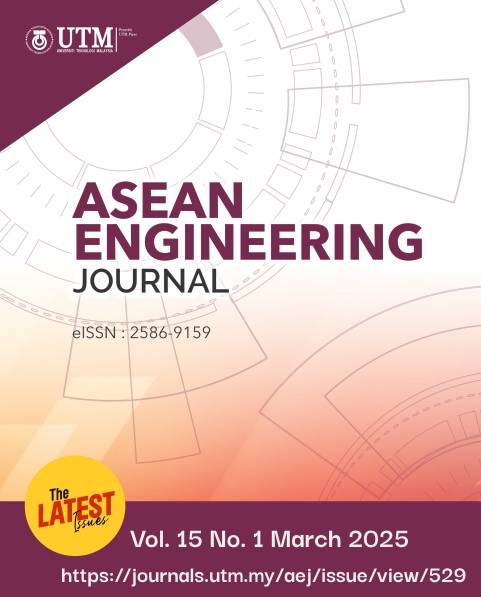DESIGN OF AERODYNAMIC PARTS TO REDUCE DRAG COEFFICIENT OF A PASSENGER VAN
DOI:
https://doi.org/10.11113/aej.v14.21115Keywords:
Van’s Aerodynamic, Aerodynamic parts, Reduce Drag Coefficient, Computation Fluid Dynamic, Van’s Aerodynamic, Aerodynamic parts, Reduce Drag Coefficient, Computation Fluid Dynamic, Aerodynamics properties of van’s fuel economy.Abstract
Air resistance plays a significant role in vehicle energy consumption. Commercial passenger vans with 7 - 12 seats are widely used for public transportation across Thailand. Most passenger vans were designed in near-rectangular shapes to maximize cabin space, which is considered poor aerodynamic efficiency and results in high fuel consumption at cruising speed. This research focused on finding suitable aerodynamic parts to reduce air resistance on such vans. The most popular van model was used as a basis for the study. It has a drag coefficient of 0.36. Effects of various aerodynamic parts on the drag coefficient reduction were studied computationally at 90 kilometers per hour wind velocity using SolidWorks Flow Simulation software. The results showed that a rear roof spoiler is the most effective aerodynamic part. Upon optimizing the spoiler geometry, the drag coefficient is reduced to 0.32. This resulted in an 5.63% reduction in fuel consumption.
References
Thai Government Gazette, Ministerial Regulations No. 60 (B.E. 2552) issued under the Land Transport Act B.E. 2522. 2552, 125 (31): 44 – 45. Ministry of Transport (Thailand), URL: https://rb.gy/9oi4r
Department of Land Transport Planning Division Transport Statistics Group. 2022. Transport Statistics Report 2022. Department of Land Transport (Thailand): 1 - 5. URL: https://web.dlt.go.th/statistics/
Chowdhury, H., Moria, H., Ali, A., Khan, I., Alam, F., Watkins, S. 2013. A Study on Aerodynamic Drag of a Semi-trailer Truck. Procedia Engineering, 56: 201-205, ISSN 1877-7058. DOI: https://doi.org/10.1016/j.proeng.2013.03.108
Huan, J., Modi, V. 1996. Design of minimum bodies in incompressible laminar flow. Inverse Problems in Engineering, 3(4): 233 - 260. DOI: https://doi.org/10.1080/174159796088027626
Wang, J., Li, H., Liu, Y., Gao, H. 2018. Aerodynamic research of a racing car based on wind tunnel test and computational fluid dynamics. MATEC Web Conf. 153(04011): 5 DOI: https://doi.org/10.1051/matecconf/201815304011
Gatto, A., Rejniak, A. A. 2022. Vehicle Having Reduced Drag. United States Patent and Trademark Office. US-20220410985-A1. URL: https://t.ly/eaook
Moradnia, P, Metka, L. M, Rao, T. P. 2023. Wheel Casing. United States Patent and Trademark Office. US-20230013812-A1. URL: https://t.ly/eE8Rj
Rose, J. D., Metka, L. M., Rao, T. P., Torris, C. 2022. Active Spoiler. United States Patent and Trademark Office. US-20220402564-A1. URL: https://t.ly/d8Tvs
Laipradit, W., Sorawat, M., Wansungnurn, P., Boonsuwan, K. 2000. Design of drag reduction device for pickup and bus. Proceedings of the 38th Kasetsart University Annual Conference: Engineering, Agro-Industry. The 38th Academic Conference of Kasetsart University. 61 - 65. URL: https://t.ly/klute
Hariram, A., Koch, T., Mårdberg, B., Kyncl, J. 2019. A Study in Options to Improve Aerodynamic Profile of Heavy-Duty Vehicles in Europe. Sustainability. 11(19): 5519. DOI: https://doi.org/10.3390/su11195519
Thai Government Gazette, Ministerial Regulations Determine the speed rate for driving on the road B.E. 2564. 2564, Prime Minister’s Office (Thailand), 138 (77): 3. URL: https://rb.gy/dwm71
Sobachkin, A., Dumnovl, G., Sobachkin, A. 2014. Numerical Basis of CAD-Embedded CFD. NAFEMS World Congress, 2013, J. 1999. Road Safety Through Video Detection. Intelligent Transportation System. 7 – 10. URL: https://rb.gy/sdwd4
Çengel, A. Y., Cimbala, M. J. Fluid Mechanics Fundamentals and Applications. 2006. 1221 Avenue of the Americas, 9: 425 – 456. New York, NY, McGraw-Hill. URL: www.mhhe.com
Toyota Motor Corporation, Toyota HiAce Commuter Brochure, 2022, 825 Third Ave., 10th Floor, New York, Toyota Tsusho America. URL: https://rb.gy/dabrp
Anderson, J. D. Fundamentals of aerodynamics / John D. Anderson, Jr. Sixth edition. 2017. 2 Penn Plaza, New York, NY, McGraw-Hill Education, Chapter 5: 431. URL: http://lccn.loc.gov/2015040997
Siddiqui, N. A., Asrar. W., Sulaeman, E. 2017. Literature Review: Biomimetic and Conventional Aircraft Wing Tips. International Journal of Aviation, Aeronautics, and Aerospace, 4(2): 6. DOI: https://doi.org/10.15394/ijaa.2017.1172
Domel, A. G., Saadat, M., Weaver, J. C., Haj-Hariri, H., Bertoldi, K., Lauder, G. V. 2018. Shark skin-inspired designs that improve aerodynamic performance. Journal of The Royal Society Interface. 15: 20170828. DOI : http://dx.doi.org/10.1098/rsif.2017.0828
Kim, J., Choi, H. 2014, Aerodynamics of golf ball with grooves. Proceedings of the Institution of Mechanical Engineers, Part P: Journal of Sports Engineering and Technology. 228(4): 233-241. DOI : https://doi.org/10.1177/1754337114543860
Staffell, I. The Energy and Fuel Data Sheet. 2011. University of Birmingham, UK, The Claverton Energy Group. URL: https://rb.gy/63o6c
Toyota Motor Corporation. 2015. Toyota’s Revamped Turbo Diesel Engines Offer More Torque, Greater Efficiency and Lower Emissions. Global Toyota website, Jun 19 2015. URL: https://global.toyota/en/detail/8348091/
Saowamon, T. 2019, MG V80 VS TOYOTA COMMUTER. 4Wheels, December (2019), Column: Test. URL: https://www.autoinfo.co.th/special/302572
Oak Ridge National Laboratory. 2008. Where the Energy Goes: Gasoline Vehicles. The official U.S. government source for fuel economy information. Office of Energy Efficiency & Renewable Energy. U.S. Department of Energy. URL: https://www.fueleconomy.gov/feg/atv.shtml
Houghton, J. T., Filho Meira, L. G., Lim, B., Treanton, K., Mamaty, I., Bonduki, Y., Griggs, DJ., Callerder (Eds), BA. Revised 1996 IPCC Guidelines for National Greenhouse Gas Inventories. 1996. UK Meteorological Office, Bracknell, IPCC/OECD/IEA, Energy 2: 1.5 - 1.8
URL: https://rb.gy/l7upp
















